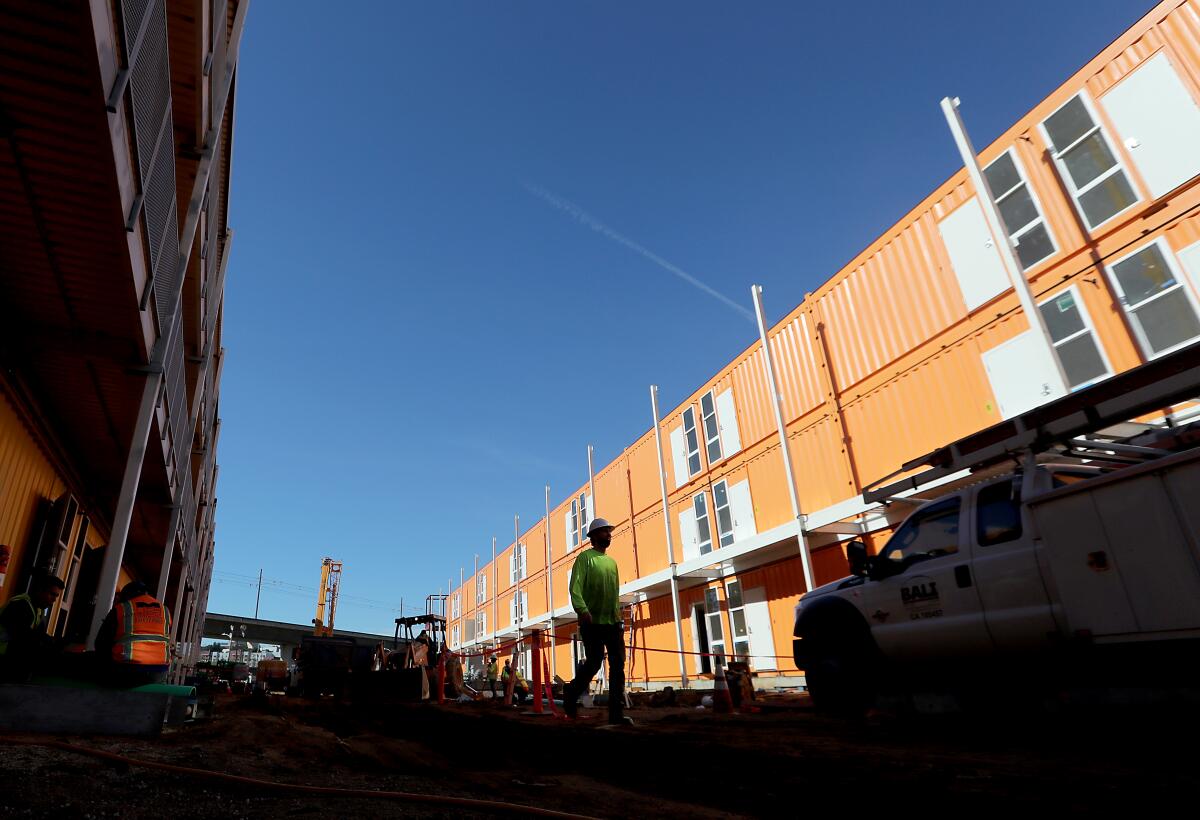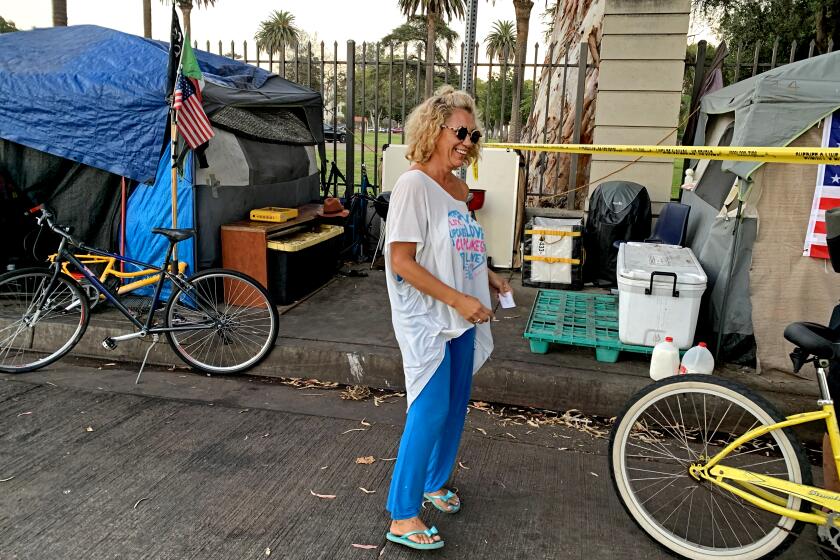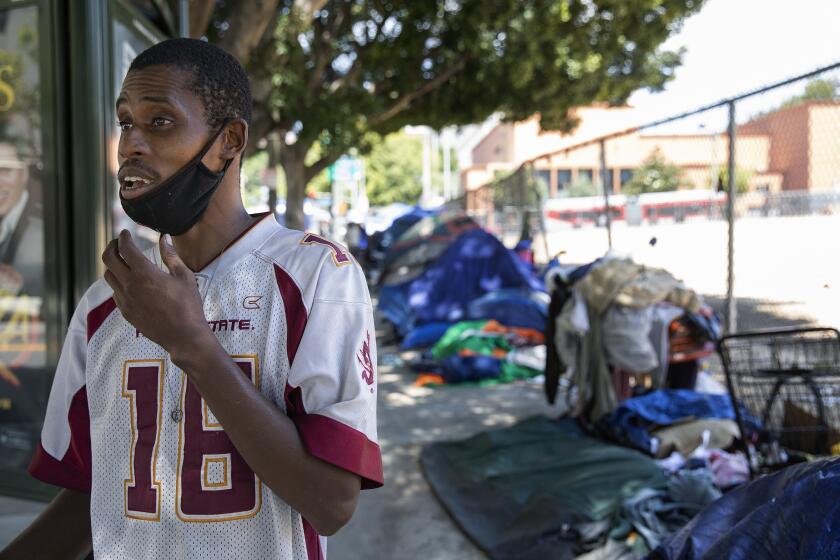What Gov. Newsom is doing right on homelessness — and how he could do better

- Share via
More than any of his recent predecessors as governor, Gavin Newsom has approached the state’s homelessness crisis with the seriousness it deserves — and has taken the right approach by embracing the Housing First concept that people should be in stable housing before they tackle their substance abuse needs. He has also, smartly, prioritized building permanent housing over shelter. The latest round of state grants for homeless services cannot be spent to create new group shelters.
Since Newsom took office in 2019, he has injected a much-needed infusion of billions of state and federal dollars into homelessness services and housing. In the current budget, $10.3 billion has been set aside for affordable housing, which will help keep more low-income Californians from falling into homelessness. An additional $12 billion will go into housing and services — but mostly housing — for homeless people. Allocation of the funds will be spread over two years. That’s the largest sum the state has ever spent on homeless housing and services in that period of time.
Much of the funding to house homeless people will go to Homekey, an innovative program in which cities, counties or other government entities — sometimes in partnership with a developer — can apply for funds to buy hotels, motels, apartment buildings and other structures that can be transformed into permanent or interim housing for homeless people. The program, which began last year with federal pandemic relief funding, helped the city of L.A. buy 15 sites to create 744 units of permanent supportive housing. The governor’s office expects 44,000 units of housing statewide to be financed through the Homekey program in the next two years.
Repurposing hotels and motels on a large scale, aided by state and federal money, is a substantial step forward in the creation of housing for homeless individuals, and Newsom should be commended for creating this program. Even with necessary renovations, buildings can be ready and occupied in a fraction of the time it takes to build from the ground up. The state also now offers subsidies for renovations on the Homekey sites.
It’s great to be able to house an entire homeless encampment. But it should be done for reasons of public access and safety, not to placate whichever neighborhood complains the loudest.
Newsom has also set aside $3 billion to create residential mental health treatment beds — which the state has far too few of — and to acquire and renovate board-and-care homes that function as housing for older or disabled low-income individuals. For many people with few resources, this kind of housing is the only thing that keeps them from descending into homelessness.
The governor’s budget also provides $2 billion in state Homeless Housing, Assistance and Prevention grants for local governments to use in a variety of ways to address homelessness in their communities. The current allocation comes with stricter guidelines than in past funding cycles. Local governments have latitude in how they use the funds, but their plans for the money must address six criteria including reducing the number of homeless people and increasing the number of homeless people who go into permanent housing.
All of this is what we want to see from the governor. Homelessness is the top concern of Californians, and addressing it requires a substantial investment in permanent housing — and a realization that prevention is essential; otherwise more people will fall into homelessness each year faster than the state can house them. At base, homelessness is about poverty.
Even with the state spending $4 billion in each of the last three years on homelessness, the population of unhoused people went up 6.8% from 2019 to 161,000 in 2020. Certainly in the county of Los Angeles, where the number went up to 66,000 — which is about 40% of the state homeless population — people fell into homelessness faster than they could be housed. The state’s funding of tens of thousands of units of housing will help, but it won’t come close to eradicating homelessness across the state.
Much of that responsibility will fall on local jurisdictions. Some advocates and local officials believe the governor should put in place a statewide strategy for working on homelessness. Jason Elliott, the governor’s senior advisor for homelessness and housing, contends that’s exactly what the governor has done by emphasizing housing, prevention, shelter and services.
A new commission on homelessness created by the L.A. County Board of Supervisors is unnecessary. The board already has plenty of studies it could use to come up with new approaches.
That’s certainly a big part of a smart statewide strategy. But to make it work, state officials will need to be tough on local jurisdictions. For example, when they apply for Homeless Housing, Assistance and Prevention grants, the state will need to make sure applicants create and execute plans that get homeless people into housing, not just connect them to outreach services.
The governor should also sign into law Assembly Bill 369, which would reimburse Medi-Cal providers who serve homeless people where they are — outside—and presume anyone who is homeless is eligible for Medi-Cal. Healthcare providers who practice “street medicine” are a valuable lifeline to homeless people who are vulnerable to illness but shy away from clinics and doctors’ offices even when they are qualified for Medi-Cal. But the California Department of Health Care Services has opposed the bill, saying it would duplicate services provided under a new system in Medi-Cal for homeless people. The governor should sign it anyway, because street medicine has been proven to work and this bill offers a way to directly deliver that health care and fund it.
The state auditor released a critical report in February saying that California’s approach to homelessness has been “disjointed” and the state lacks one single entity overseeing efforts to address the problem. “Instead, at least nine state agencies administer and oversee 41 different programs that provide funding for purposes related to homelessness,” the report stated.
Newsom has resisted calls to create a homelessness “czar,” but he did this week sign Assembly Bill 1220 ,which reconstitutes the Homeless Coordinating and Financing Council into the California Interagency Council, a new more powerful agency that will oversee the administration of Homeless Housing, Assistance, and Prevention grants. Will the council have an impact? Maybe. The governor has set a high bar for local governments seeking those grants ,and it will be up to the council to guide those grant seekers and give them the help they need.
Yes, there’s no question that the bureaucracy around homelessness services is staggering. But the state has dished out a lot of money — at least for the next two years — to cover almost every conceivable aspect of homelessness. After that, the state will have to figure out how to keep money flowing into ongoing programs. But right now, the question is whether the state can steer those funds into the right local programs and put them to work.
More to Read
A cure for the common opinion
Get thought-provoking perspectives with our weekly newsletter.
You may occasionally receive promotional content from the Los Angeles Times.












